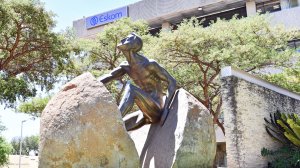Eskom aiming to secure concessional funding for R400bn just energy transition project pipeline
State-owned electricity producer Eskom has identified a pipeline of ‘just energy transition’ projects valued at about R400-billion that it will seek to fund using concessional finance raised from international financiers that have committed to supporting decarbonisation initiatives in developing countries, including South Africa.
Just Energy Transition GM Mandy Rambharos reported on Thursday that the pipeline includes wind, solar and gas and battery projects, some of which will be deployed at its decommissioning coal power stations, starting with Komati in 2022.
It also includes the building of at least 8 000 km of transmission lines, 12 new substations in four provinces, the deployment of 110 transformers by 2030 to strengthen the network, the reinforcement of critical distribution corridors and the deployment of microgrids in locations that are hard to electrify using grid electricity.
Eskom is proposing to fund the projects through a Just Energy Transition financing facility, which has been conceptualised as a multi-tranche, multi-year facility, funded by a multi-lender syndicate on a “pay-for-performance basis”.
Rambharos said the facility, which she likened to a building loan, has been canvassed with various lender counterparties, which have expressed enthusiasm for its simplicity.
There is also strong support for the fact that there is an option to opt-out from projects that might not be covered by lender mandates, such as gas-to-power projects.
The facility was also discussed with climate envoys from France, Germany, the UK, the US and the European Union who visited South Africa in late September as part of preparations for the COP26 climate talks scheduled for Glasgow, Scotland, in November.
During the visit, it was agreed that the ‘Just Transition Financing Facility’ should be supported to enable South Africa to implement, starting with Eskom, its more ambitious climate action plans, while also addressing the social impacts of the transition.
South Africa has deposited an updated Nationally Determined Contribution range of 420- to 350-million tons of carbon dioxide equivalent (Mt CO2-eq) for 2030 with the United Nations Framework Convention on Climate Change, which represents a marked improvement on its 2015 pledge of 614 Mt CO2-eq to 398 Mt CO2-eq.
THREE FIVE-YEAR TRANCHES
Speaking during a webinar hosted by the South Africa Oil & Gas Alliance, Rambharos said that Eskom currently envisages the facility being rolled out in three five-year tranches to 2035.
However, it was premature, she said, to indicate how much the utility would seek to raise in each tranche as discussions were still under way.
It was likely, though, that the first tranche would be significantly smaller than the subsequent tranches as the initial funding would be for feasibility studies to progress the projects to bankability.
It was also too early to state what impact the new loans would have on Eskom’s already unsustainable debt profile, but Rambharos stressed that the potential lenders it had canvassed had indicated an eagerness to provide Eskom with funding support for its transition, despite its current debt problem.
Eskom did not envisage using the facility to address its legacy debt, however, and was in separate discussions with the National Treasury to find a debt solution. It also did not aim to pursue any debt forgiveness in return for decarbonisation.
Rambharos could also not say what the lending-rate differential would be under the financing facility, saying only that it would be seeking “highly concessional” terms relative to what was available commercially.
Eskom had also taken a decision to include gas-to-power in its just transition strategy, despite growing opposition to the use of gas globally.
The decision was based on the need for a ready-made technology to complement the variability of renewable energy so as to accelerate the transition from coal and possible transition to green hydrogen in time.
However, Rambharos stressed that Eskom’s long-term vision was to become a renewable energy company and to deploy gas as a transition fuel.
The gas projects listed in Eskom’s just transition strategy included a 1 000 MW repowering project at the Komati power station site and 3 000 MW at Richards Bay, in KwaZulu-Natal.
Article Enquiry
Email Article
Save Article
Feedback
To advertise email advertising@creamermedia.co.za or click here
Comments
Press Office
Announcements
What's On
Subscribe to improve your user experience...
Option 1 (equivalent of R125 a month):
Receive a weekly copy of Creamer Media's Engineering News & Mining Weekly magazine
(print copy for those in South Africa and e-magazine for those outside of South Africa)
Receive daily email newsletters
Access to full search results
Access archive of magazine back copies
Access to Projects in Progress
Access to ONE Research Report of your choice in PDF format
Option 2 (equivalent of R375 a month):
All benefits from Option 1
PLUS
Access to Creamer Media's Research Channel Africa for ALL Research Reports, in PDF format, on various industrial and mining sectors
including Electricity; Water; Energy Transition; Hydrogen; Roads, Rail and Ports; Coal; Gold; Platinum; Battery Metals; etc.
Already a subscriber?
Forgotten your password?
Receive weekly copy of Creamer Media's Engineering News & Mining Weekly magazine (print copy for those in South Africa and e-magazine for those outside of South Africa)
➕
Recieve daily email newsletters
➕
Access to full search results
➕
Access archive of magazine back copies
➕
Access to Projects in Progress
➕
Access to ONE Research Report of your choice in PDF format
RESEARCH CHANNEL AFRICA
R4500 (equivalent of R375 a month)
SUBSCRIBEAll benefits from Option 1
➕
Access to Creamer Media's Research Channel Africa for ALL Research Reports on various industrial and mining sectors, in PDF format, including on:
Electricity
➕
Water
➕
Energy Transition
➕
Hydrogen
➕
Roads, Rail and Ports
➕
Coal
➕
Gold
➕
Platinum
➕
Battery Metals
➕
etc.
Receive all benefits from Option 1 or Option 2 delivered to numerous people at your company
➕
Multiple User names and Passwords for simultaneous log-ins
➕
Intranet integration access to all in your organisation





















